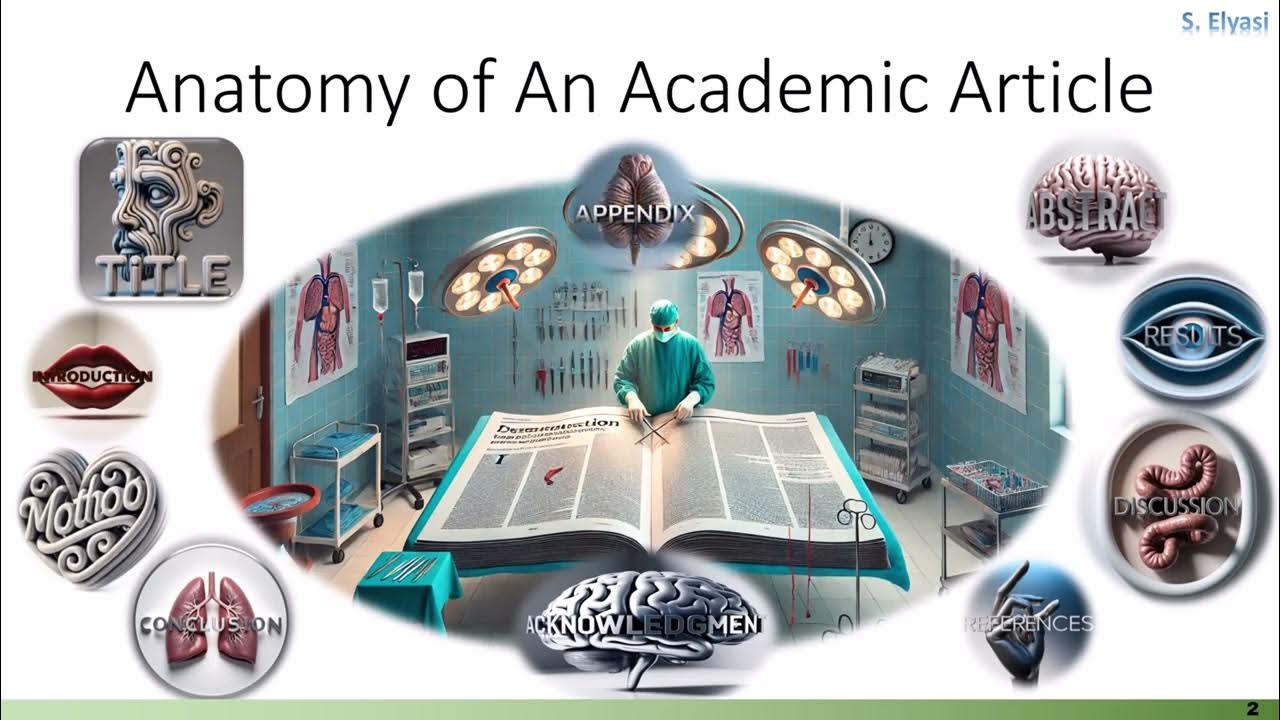How to write the Discussion part 1
Summary
TLDRThis script offers a comprehensive guide to crafting the Discussion section of a research paper. It emphasizes interpreting results, comparing them with expectations and previous studies, and addressing unexpected findings with citations. The author advises on evaluating explanations, considering limitations, and suggesting future research. The script also illustrates how to synthesize results into a coherent narrative, ending with a conclusion that highlights the study's significance and potential applications.
Takeaways
- 📚 The Discussion section is the fourth and final part of a research paper, following the Results section, where the meaning of the results is explained.
- 🔍 It's essential to compare actual results with expected outcomes based on the hypothesis and with findings from other researchers, using citations to support comparisons.
- 🤔 The Discussion should address unexpected results and provide potential explanations, supported by citations, and suggest how these could be tested.
- 🔑 The section challenges authors to demonstrate the depth and clarity of their scientific thinking by interpreting results and evaluating proposed explanations.
- 📈 Authors typically start the Discussion by reviewing the main results, which should align with the study's purpose stated in the Introduction.
- 📊 Unlike the Results section, Discussion allows for interpretation of the meaning behind the data, such as associating behaviors with relaxation or stress.
- 🧠 The Discussion should not just restate results but explore them, combining information from multiple figures or tables to form a coherent point.
- 📝 When discussing unexpected results, authors should provide scientific explanations before discussing experimental limitations and suggest future experiments.
- 🔬 The Discussion should consider all possible explanations for the data, not just the preferred one, and assess the validity of each explanation.
- 📉 Even if results are non-significant, they may still be relevant if similar findings exist in the literature, and authors should highlight these connections.
- 📋 The conclusion of the paper should review main points, discuss the study's importance, acknowledge limitations, and suggest directions for future research without apologizing for any shortcomings.
Q & A
What is the purpose of the Discussion section in a research paper?
-The purpose of the Discussion section is to interpret the meaning of the results obtained in the research, explain how they compare with expected outcomes and previous studies, and to explore the implications and applications of the findings.
What should be the first step in writing the Discussion section?
-The first step is to review the main results of the paper, ensuring that it ties up with the statement of purpose made at the end of the Introduction.
How does the Discussion section differ from the Results section?
-While the Results section presents the data and observed trends without interpretation, the Discussion section allows for the interpretation of the results, their significance, and comparison with other studies.
Why is it important to compare your results with those of other researchers?
-Comparing results helps to contextualize your findings within the existing body of research, highlighting similarities, differences, and potential areas for further investigation.
What should be done when unexpected results are found?
-Unexpected results should be explained with scientific reasoning, supported by citations, and potential future experiments should be suggested to address these findings.
How should limitations of the experimental design be addressed in the Discussion section?
-Limitations should be acknowledged and discussed in the context of how they may have affected the results, along with suggestions for how they could be mitigated in future studies.
What is the role of citations in the Discussion section?
-Citations are used to support interpretations, compare findings with previous research, and provide a scientific basis for the explanations and hypotheses presented.
How should the Discussion section conclude?
-The Discussion should conclude by summarizing the main points, stating the significance and potential applications of the research, acknowledging limitations, and suggesting directions for future research.
Why is it beneficial to suggest future experiments in the Discussion section?
-Suggesting future experiments helps to highlight the ongoing relevance and importance of the research topic, and it provides a pathway for other scientists to build upon the findings.
How can the Discussion section be used to enhance the reader's understanding of the research?
-The Discussion section can enhance understanding by providing a critical interpretation of the results, exploring their broader implications, and connecting the findings to the wider research field.
What is the relationship between the Introduction and the Discussion sections in a research paper?
-The Introduction narrows down from the wider research field to the specifics of the study, while the Discussion expands from the study's details to the broader research context, providing a full-circle understanding of the research.
Outlines

このセクションは有料ユーザー限定です。 アクセスするには、アップグレードをお願いします。
今すぐアップグレードMindmap

このセクションは有料ユーザー限定です。 アクセスするには、アップグレードをお願いします。
今すぐアップグレードKeywords

このセクションは有料ユーザー限定です。 アクセスするには、アップグレードをお願いします。
今すぐアップグレードHighlights

このセクションは有料ユーザー限定です。 アクセスするには、アップグレードをお願いします。
今すぐアップグレードTranscripts

このセクションは有料ユーザー限定です。 アクセスするには、アップグレードをお願いします。
今すぐアップグレード関連動画をさらに表示

How to write a scientific paper

How To Write The Discussion Section For Your Research Paper (DETAILED GUIDE)

Anatomy Of An Academic Article Part 1 Overview and Title

How to Write the Background of the Study in Research (Part 4).

WRITING THE RESEARCH INTRODUCTION//TECHNIQUES + BONUS TIPS #PracticalResearch#ResearchPaper

How to write a research report in English|Academic Writing
5.0 / 5 (0 votes)
